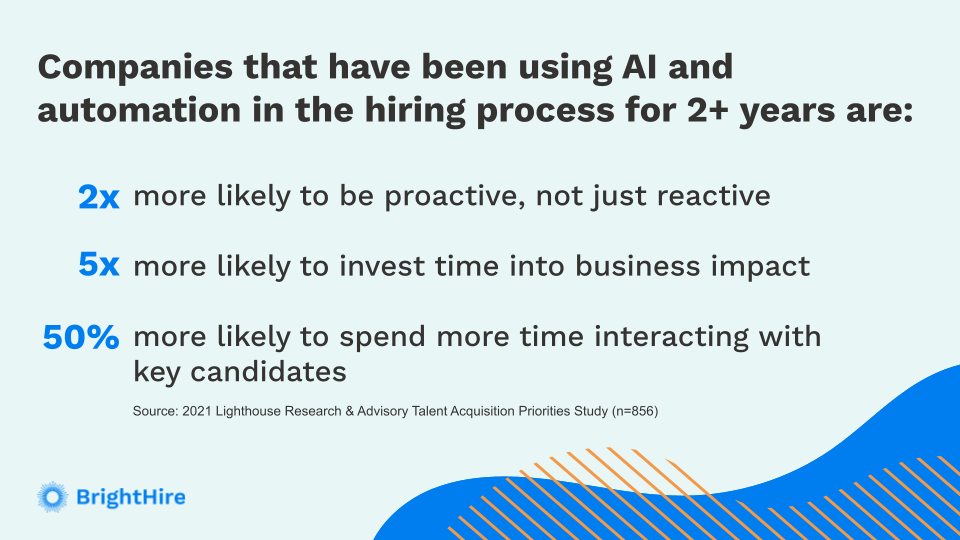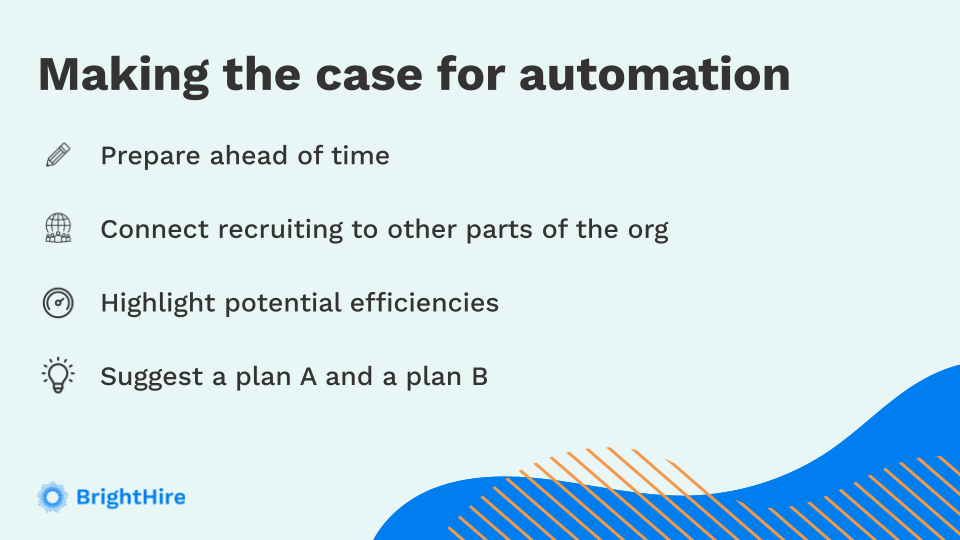Everyone in the talent acquisition space seems to be talking about recruiting automation, which makes sense given the number of challenges recruiters are facing. Many recruiting teams are trying to fill an unprecedented number of open roles despite a shortage of resources and bandwidth, and this trend doesn’t look to be slowing down anytime soon.
With automation as the obvious strategy to help recruiters accomplish more with less, we asked three experts to share their knowledge on the right way to build a recruiting automation strategy, while avoiding the most common mistakes or pitfalls. This group included:
- Ben Eubanks – Chief Research Officer at Lighthouse Research & Advisory
- Andres Blank – Co-founder & CEO at Fetcher
- Hayli Thornhill – Head of Recruiting at BrightHire
While the panel represents a unique combination of backgrounds and experience, one perspective unites them: recruiting is human, and automation efforts need to strike the right balance between efficiency and humanity.
With that principle serving as the foundation of the conversation, the panel turned their attention to the four biggest mistakes that often stifle recruiting automation efforts:
- Waiting too long to automate
- Automation paralysis
- Failing to prove the business case
- Insufficient adoption
1. Waiting too long to automate
With many talent leaders just trying to keep their heads above water, it’s understandable that the process of researching and vetting automation solutions often gets put on the back burner. But there are some come clear signs that a team might have waited too long to adopt automation, including:
- Recruiters becoming increasingly stressed
- The quality of hires begins to decrease
- Recruiters feel like they don’t have time to do the tasks they actually enjoy doing
Beyond the qualitative impacts of waiting too long, Ben shared some data that captures the additional value being left on the table in delaying automation efforts.

2. Automation paralysis
For leaders that have already decided the time is right to explore automation options, some of them might soon find themselves suffering from automation paralysis. In short, there are endless tools and platforms for talent leaders to choose from, and deciding where to start can be overwhelming.
Even after selecting which solutions to implement, Ben shared an interesting insight that further compounds the paralysis leaders often experience around automation decisions ????
As Ben explains, more systems might result in more productivity, but it can also create less certainty around a “source of truth.” To overcome this challenge, the panel recommends:
- Don’t get hypnotized by complex “frankenstack” solutions that purport to do everything—identify the key functionality that you are looking for, and prioritize those pieces when evaluating.
- Look for vendors who want to partner with your team to create success. This partnership mindset is essential to getting the most value from automation solutions. Or as Andres explained, “automation is about trust.”
- Don’t dismiss a tool or platform because it would require altering existing workflows. Adaptation is often an important part of embracing automation.
3. Failing to prove the business case
Even when a talent leader is ready to implement recruiting automation, they are typically not the sole decision-maker. Investing in new platforms often means sign-off from leadership, and that requires strategic preparation in order to be successful.
Hayli, Ben and Andres all agree that the most important thing recruiting leaders can do to prove the business case for recruiting automation is to prepare. These conversations should occur only after the TA leader has spent adequate time to connect the work their team does with objectives across the org (for example, the impact of scaling the sales team in order to meet quarterly targets). Leaders need to explain efficiencies that can be gained exclusively through automation, estimate potential time savings, and emphasize the universal adage that time = money.
One additional recommendation: present multiple options. Recruiting leaders should prepare a plan A and a plan B, and clearly communicate how each approach will impact efficiency and the ability to meet broader company goals.

4. Insufficient adoption
Once a new automation tool is in place, that doesn’t mean the battle is over. With a majority of companies opting for a pilot before committing, recruiting teams need to commit enough time and effort to properly vet the effectiveness of the tool. Teams also must be willing to evolve their processes, rather than sticking to the old way of doing things. Hayli explained why trust between recruiting leaders and their team is essential to this process ????
If a leader has created an open, trusting environment with their team, then they can trust the feedback they receive around new automation solutions. It also helps if leaders know which strengths already exist on their team and what could be improved through automation—leaders can use this knowledge as an input when determining an effective automation strategy.
Takeaways
While the mistakes discussed during the webinar might be common, they shouldn’t make recruiting leaders nervous. Automation, when done correctly, lets recruiters do more of the tasks they enjoy, while also helping companies hire talented people that might otherwise get overlooked ????
Watch the complete webinar
There were a ton of additional insights and recommendations discussed, so we’d recommend watching the complete webinar to hear the complete conversation.









